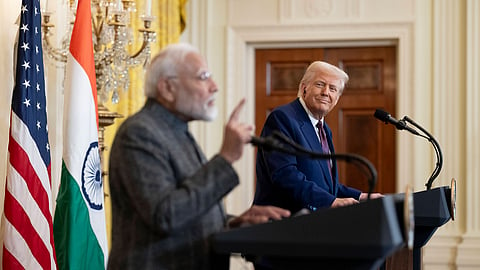Trump’s approach to Southasia bolsters China’s regional sway
IT HAD BEEN four years since Myanmar’s military junta seized power in a violent coup executed on 1 February 2021. Yet the day marking the coup in 2025 passed with hardly a blip on the international news tickers. Instead, the news was dominated by the latest tariff proclamations coming out of Washington DC, targeting Canada, China and Mexico. Four years on, Myanmar has fallen off the global attention spectrum as dramatically as it had claimed it when the coup was first launched.
A decade earlier, too, Myanmar was especially in the global limelight. In November 2014, US president Barack Obama arrived in Myanmar to talk democracy. To many in the country, then in the early years of an attempted transition to democracy, it seemed the final break from decades of brutal military rule. “Today, I say to you – and I say to everybody that can hear my voice – that the United States of America is with you, including those who have been forgotten, those who are dispossessed, those who are ostracized, those who are poor,” Obama pledged at the University of Yangon.
“Yangon, that day when Obama visited first, was like it was getting ready for an epoch-making event,” a Myanmar national who had daily interactions with the US mission during the Obama visit said. In 2014, US assistance to Myanmar reached USD 150 million. The Myanmar national said it had felt like the United States had matched the verbal bravado with action and was invested in Myanmar’s future. He, like so many in Myanmar, trusted the United States’s word. That turned out to be a mistake.
As Donald Trump, the newly installed president of the United States, has deployed his policy of “America First”, with no concern for anything that he sees as incompatible with narrow-minded US interest, the old promises to Myanmar have been thrown by the wayside. Take, for instance, Trump’s recent executive order freezing US foreign aid. In the 12 months up to October 2024, under the preceding US administration led by Joe Biden, the United States spent nearly USD 141 million to assist Myanmar’s “crisis-affected communities facing armed conflict, displacement, and growing food insecurity.” Now, the future of all of that support is under question. By mid-February, the community of exiled Myanmar media working from exile in the Thai border town of Mae-Sot was reeling. The Irrawaddy, a popular news outlet, was dependent on US funding for some 35 percent of its budget via media support from the non-profit group Internews.
“The Americans just forgot about us,” said a journalist and activist from Myanmar who was forced into exile following the 2021 coup. The fear, he told me, is that Myanmar is unlikely to be a priority for the US under Trump.
Myanmar exemplifies how the volatility of US policy can have drastic consequences across the world, including in Southasia. Myanmar is hardly the only country in the region to be hit hard by Trump’s new policies, going beyond just the suspension of aid. When it comes to the Trump administration, “if you just look at it in terms of the list of things to tackle right away, I think Southasia does not come at the top of that now,” Rohan Venkat, the managing editor at the University of Pennsylvania’s the Centre for Advanced Study of India, said. That is opening up opportunities for other players, especially China, to make gains in Southasia as countries re-evaluate their earlier relationships with and reliance on the United States.

